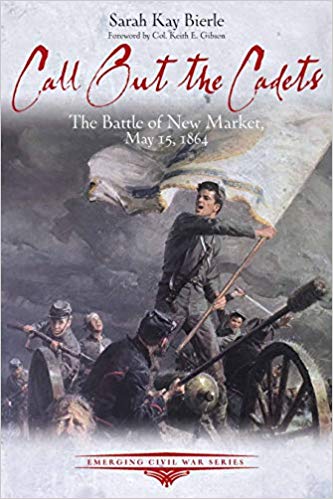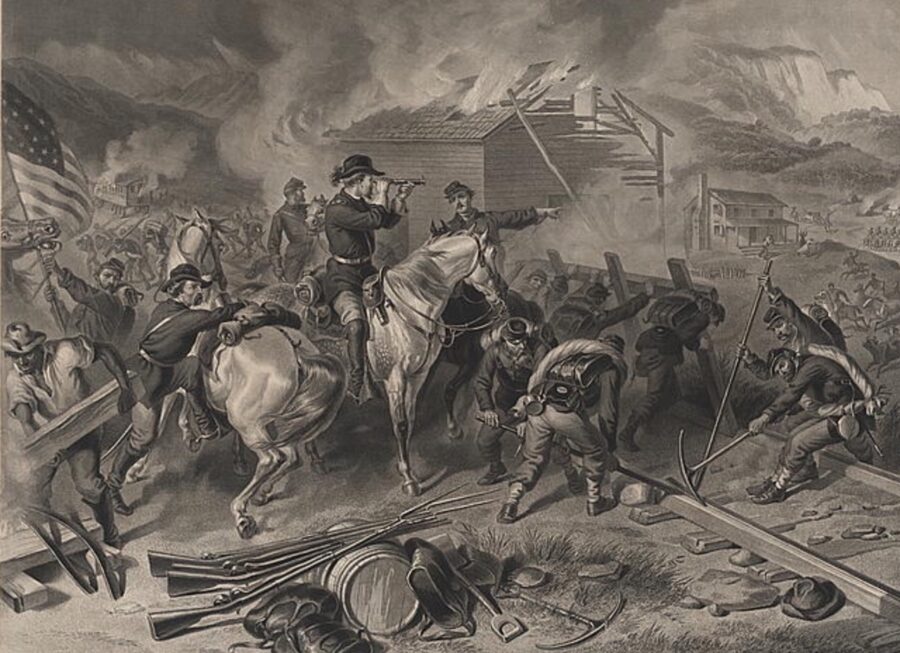Call Out the Cadets: The Battle of New Market, May 15, 1864 by Sarah Kay Bierle. Savas Beatie, 2019. Paper, ISBN: 978-1611214697. $14.95.
 Military activity occurred incessantly throughout the Civil War in Virginia’s Shenandoah Valley. While some of those engagements—most notably the battles of General Philip H. Sheridan’s 1864 Shenandoah Campaign—ultimately proved significant to Union victory, arguably none of the battles fought in the Valley is more popular than the clash between Confederate general John C. Breckinridge and Union general Franz Sigel at New Market.
Military activity occurred incessantly throughout the Civil War in Virginia’s Shenandoah Valley. While some of those engagements—most notably the battles of General Philip H. Sheridan’s 1864 Shenandoah Campaign—ultimately proved significant to Union victory, arguably none of the battles fought in the Valley is more popular than the clash between Confederate general John C. Breckinridge and Union general Franz Sigel at New Market.
Fought on May 15, 1864, New Market’s popularity springs from the significant role Virginia Military Institute (VMI) cadets played in the battle. Prolific author William C. Davis (one of my professors in graduate school at Virginia Tech) penned the first modern history of the battle in 1975. Thirty-five years later, Charles Knight reexamined the battle in his masterful study, Valley Thunder. Now, almost a decade after Knight’s study, Sarah Kay Bierle has added her voice to New Market’s growing literature.
Bierle, the managing editor at Emerging Civil War and author of several works of historical fiction, has produced a fast-paced narrative. A battlefield tour enhances this study, which is her first non-fiction volume.
Throughout the book, Bierle commendably describes the backgrounds of the battle’s major figures and the composition of the contending armies. Additionally, she does an admirable job of describing the battlefield’s topography and the battle’s ebb and flow. Throughout, Bierle shows her talent as a historian and author by weaving in stories of how soldiers who fought at New Market felt going into the fight, during the action, and in its aftermath. For example, she recounts how Breckinridge’s veterans teased VMI cadets on the morning of May 15 due to their “solemn appearances in the pre-battle dawn” (63). Those same cadets who endured criticism that morning were immortalized by day’s end.
Perhaps most praiseworthy is that Bierle never loses sight of the fact that the battle did not occur in some remote hinterland, but rather in a larger community. Throughout the book, Bierle ably examines New Market’s demographics and highlights stories of civilians who played critical roles in caring for wounded Union and Confederate soldiers in the battle’s aftermath. The author’s examination of the efforts of individuals such as Eliza Clinedinst Crim and Solomon and Jesse Rupert not only reveal the ways in which battle impacted civilians, but also illustrates divisions that existed among New Market’s inhabitants. While Crim supported the Confederate war effort, the Ruperts harbored pro-Unionist sympathies. Bierle not only discusses the aid the Ruperts offered to wounded Union soldiers, but extends their story to the postwar years when they operated a school for African Americans.
Enhancing this volume are three appendices. The first, a series of primary excerpts previously published in Shenandoah at War (the magazine of the Shenandoah Valley Battlefields Foundation) in 2018, offers a nice array of accounts from soldiers and civilians. Troy Marshall, site director of the Virginia Museum of the Civil War and New Market Battlefield State Historical Park, contributed a fascinating essay about the early preservation efforts at New Market and the critical role George Randall Collins played in making certain some of the battle’s most significant landscapes would be protected in perpetuity. Historian David Powell rounds out the volume with an examination of New Market’s legacy at VMI.
Despite this book’s many fine attributes, it does contain one error—repeated twice—that will be readily apparent to Shenandoah Valley Civil War historians. At two different points in the book Bierle mentions that Union colonel George Wells of the 34th Massachusetts Infantry is buried in the Winchester National Cemetery (116, 123). Wells, mortally wounded in a melee along the banks of Cedar Creek on October 13, 1864 (not to be confused with the battle fought in the same area six days later), is buried in Green River Cemetery in Greenfield, Massachusetts.
Additionally, historians might take issue with Bierle’s conclusion that “the battle of New Market marked the last decisive Confederate victory in a large-scale battle in the Shenandoah Valley” (146). Most would argue that Confederate general Jubal Early’s rout of Union general George Crook at the Second Battle of Kernstown on July 24, 1864, holds that distinction. Second Kernstown involved more than double the total number of troops engaged at New Market.
Those issues, easily corrected in future editions, do not detract from this volume’s overall usefulness. Bierle’s book, like all those in the Emerging Civil War Series, is concise, profusely illustrated, cogently written, and engaging. Anyone interested in the Civil War era in the Shenandoah Valley will find this volume quite valuable.
Jonathan A. Noyalas is director of Shenandoah University’s McCormick Civil War Institute, founding editor of Journal of the Shenandoah Valley During the Civil War Era, and the author or editor of eleven books on Civil War era history.

